
Nice bakelite camera manufactured by the Eastman Kodak Company from 1936 to 1942. It uses a meniscus as a lens, a single glass, convex facing the outside of the camera and concave on the inside. The diaphragm is behind the lens and is fixed at f/16. The shutter release is the small lever you see on the left in the photo above. The small button on the opposite side allows you to choose speeds of 1/50s or B. It is therefore a camera that practically eliminates the need for a light meter since for instant photographs there is no other option than 1/50s and f/16.
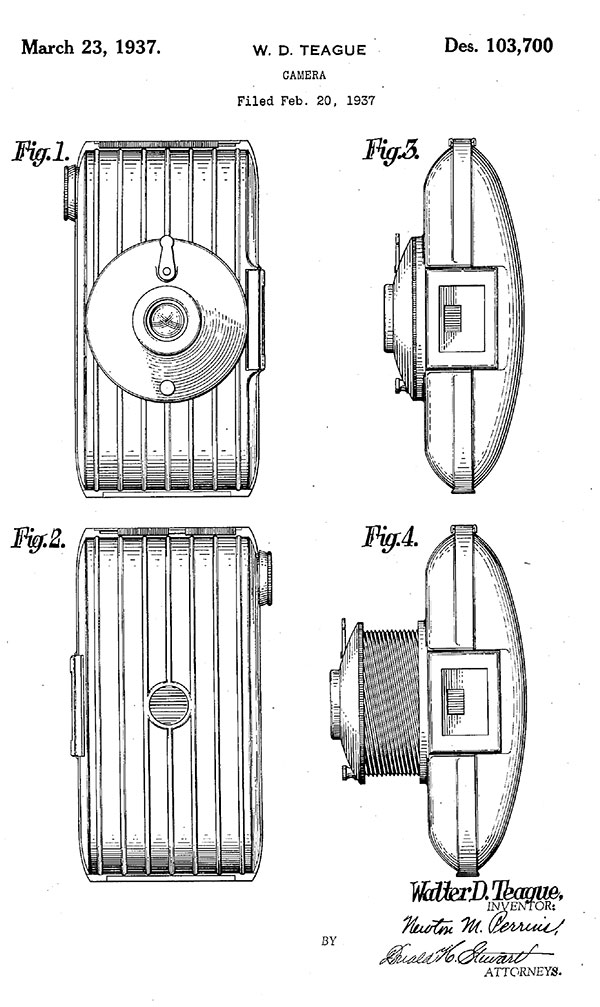
The Bullet’s strong point is the Art Deco design by the famous Walter Dorwin Teague, who designed several cameras for Kodak. Above, we have the technical drawing of the camera as it was presented for the issuance of its patent. Bakelite offers a certain freedom in the use of curves compared to metal plates, normally used in box cameras. It actually works better with rounded surfaces than with sharp edges as it is not very resistant to shock and is easily chipped. It is very pleasant to the touch as it has high hardness without the coldness of metals. It has an elegant shine that does not require any painting or finishing. There were several camera models launched, not only by Kodak, using bakelite. Today they are all highly sought after by collectors, they were produced in thousands, not hard to find, but more than often are found broken, as I said, bakelite it is not a very impact-resistant material.

With its rounded shape, it is a camera that fits well in a coat pocket or handbag. But this required the use of a collapsible objective using a helicoid. This highlights another interesting aspect of bakelite, which is its dimensional precision. Few moldable materials would allow such a fine fit for the use of the helicoid as we see in the photo above. When in position and ready for use, the lens is locked by a click.
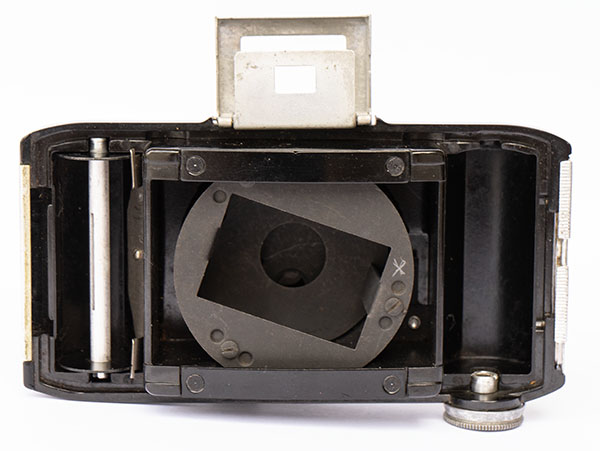
Inside, a metal plate works as a stop to arm and disarm the objective.
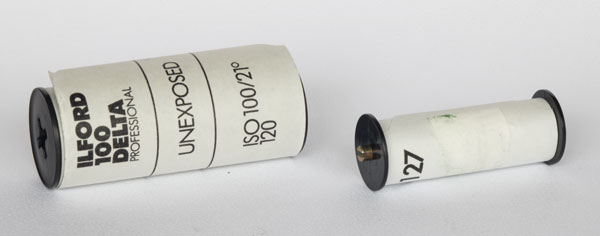
The Kodak Bullet uses 127 format film which is a slightly smaller reel than the more well-known 120 film. Currently, as of the publication date of this post in late 2023, there are still some manufacturers offering this format. Due to the low sales volume, it is more expensive than 120 film. My strategy is to cut 120 film and spool it on old 127 reels. I made a complete tutorial showing the process I use: respooling 127 film.
The height of the film is 46mm (1⅝”) and this camera cuts the length to 63mm (2½”). A 46 x 63 mm frame with a 60mm focal length lens gives a horizontal viewing angle of 55º and 66º diagonally (you can do these calculations easily in this page). This is already a reasonably large viewing angle, especially if we consider that the lens is just a meniscus. To somewhat compensate for this situation, the film is slightly curved inside the camera, providing a better fit to the curvature of the image.
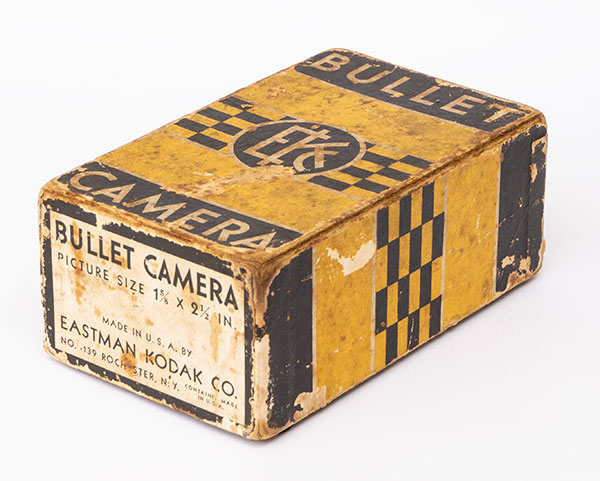
Like most cameras of that time, in which design was a strong point, the packaging was also well cared for and many of them, due to their beauty, silently claimed the right to remain over time and were not discarded. It’s not that difficult to find a Kodak Bullet with its original box.
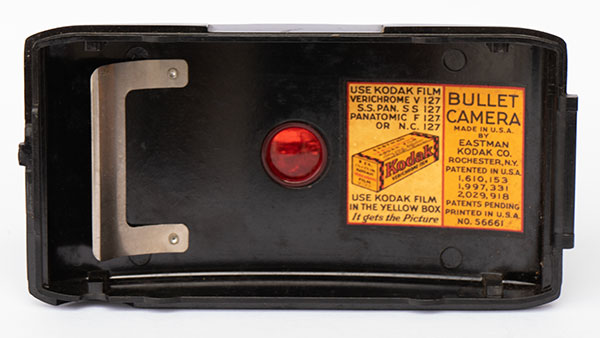
The rear camera cover comes off completely. It fits on the right side (pictured above) and has a bulge (opposite side) that locks with a sliding metal clasp onto the camera body. This example from the collection had this protrusion broken and therefore did not close very reliably. However, the good news is that this could be fixed. I made a small hole in the area and filled it with epoxy putty. The hole was to better anchor the added material. After the epoxy mass hardened, which is very machinable, it was filed to give the exact shape and then painted in the color of the bakelite. It was as if he had never had a problem. Here’s some hope for repairing other bakelite parts.
The photos are advanced manually, following the number marked on the paper that protects the film through the red window in the center of the back of the camera (photo above). Many cameras that use this feature have a sliding cover to keep this window closed whenever possible. I’ve seen some photographers put an opaque sticker on the outside of the camera to block any light leaking through that window. However, I have not used this type of extra protection and my experience is that using modern films, the “backing paper” is enough to avoid staining the film. Perhaps in the past this would have been a necessary measure.
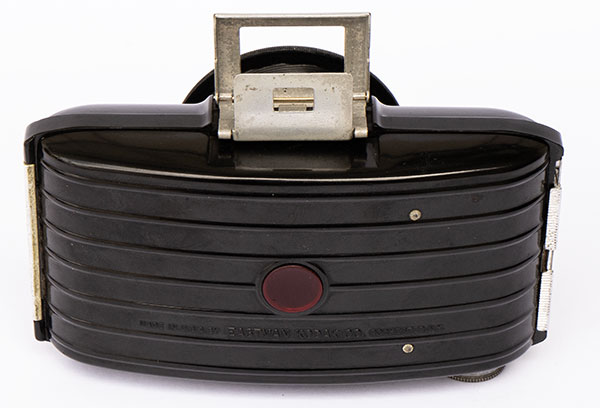
Framing is done using a sports-type viewfinder, without any optics, and it is important to place your eye firmly against the “eyepiece” to get a frame that is more in line with what will appear in the final photo. But this is not a big problem because with such a simple lens, in any case, you should not count on objects that are on the periphery of the image as in this region aberrations greatly deteriorate the its definition. It is better to place the main subject more in the center of the image and then the framing is no longer so critical.
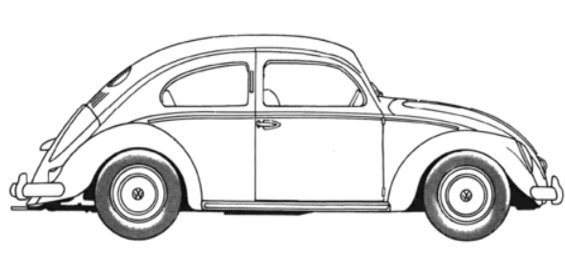
After a basic cleaning and fixing the lock I wanted to go out and feel the Kodak Bullet in use. The perfect opportunity soon appeared. That’s when I found out that there would be an annual meeting of Beetle owners here in my city. Also created in the 1930s, the Beetle was not made of bakelite, but its rounded shapes seem to match those of the old Kodak Bullet. Here are some snapshots from sunny Sunday, perfect for the 1/50s f/16.




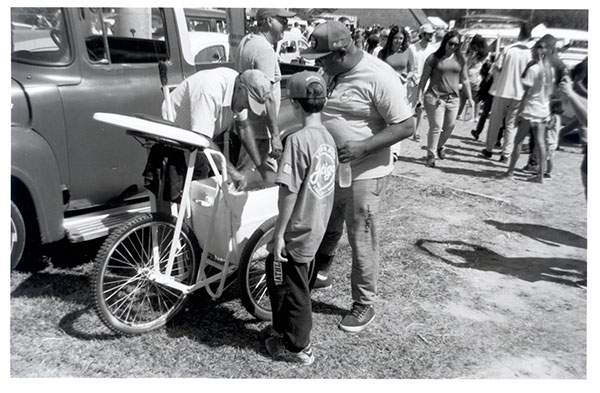

How can I find out how much is a Kodak camera is worth. I have several old cameras. I have a video record camera that is a Kodak.
You can check auction sites as a reference. Put some comeras like yours in your watch list and check whether they sell or not in a few weeks. The point with auction sites is to avoid being fooled by some crazy people who asd a fortune for a camera and are just there with no chance of finding a buyer. That is why I advise you to follow it up for a while and track real sales. Or you can take them to a camera store dealing with antiques and get an advice.
NÃO SEI O PRÊÇO MAS ESTOU INTERESSADO, NÃO EXISTE MAIS O FILME 127!
Olá Israel, se o seu interesse é em comprar, essa câmera não está à venda, eu raramente vendo alguma câmera/lente da coleção especialmente se já fiz fotos com ela. Mas não é uma câmera muito rara. Procurando vc deve achar. O filme 127 ainda é fabricado, mas por poucas marcas. Dê uma olhada na web. Eu acho que o mais interessante é comprar alguns rolinhos só para ter o carretel e o backing paper e depois cortar o filme 120 e enrolar no 127. Eu mostro um jeito de fazer isso nessa página: Rebobinando filme 127 a partir de 120
I have one of these camera that I bought from a Goodwill store for about $12. I didn’t know what it was, but I would have bought it simply because it was Bakelite, but the freaking thing WORKS and even had the takeup spool.
I didn’t want to pay for 127 film, so I use 35mm film and roll it onto the spool in the dark. I bought an old expired 127 roll to get another metal spool, but 35 mm absolutely works. You get the sprocket holes, but that just adds to the feel, and 35mm black and white is relatively inexpensive. Great info. Love the patent drawing!
Thank you!
Good morning wlungov,
I just bought this camera as a gift to my friend who collects old cameras.
I can’t unfold the viewfinder, nor understand how to deploy the lens, which doesn’t seem to unscrew.
I can’t find instructions online, but maybe you can help?
Many thanks in advance and congratulations for your beautiful blog!
Aude
The viewfinder must be pulled from the back and should pop-up and stay in place by an action spring. The top plate is hinged on the front.
Grab the lens tube by its knurled rim at the border. Turn it counterclockwise while gently pulling it outwards.
Hope this helps